Professional teeth cleaning using the Air-Flow method. Air flow - effective whitening and quick results
A beautiful snow-white smile can add a certain attractiveness to the appearance of any person. But, unfortunately, few people can boast of the natural beauty and whiteness of their teeth. This is most often due to the fact that many foods consumed have coloring properties. Plaque also forms on the tooth enamel, and tartar forms in the supragingival and subgingival areas.
Daily brushing of teeth at home cannot prevent all of the problems described above. That is why dentists recommend professional teeth cleaning 2-3 times a year. Teeth cleaning with the Air Flow device is most popular among patients at dental centers.
Features of the Air Flow procedureWhat is it - cleaning Air teeth Flow – not everyone knows. The operating principle of the device is identical to the operating principle of industrial sandblasting equipment. Only for cleaning and polishing the teeth, it is not sand that is used, but sodium bicarbonate (baking soda).
Professional teeth cleaning Air Flow is based on organizing a powerful cleaning flow from a water-soda suspension and air. Very often they add to the cleaning agent essential oils or lemon essence. This allows you to bring a refreshing effect to the procedure.
Air Flow ultrasonic teeth cleaning algorithm
Professional teeth cleaning using the Air Flow method is performed as follows:
- Initially, the patient is asked to wear safety glasses and a special cap. The lips are lubricated with Vaseline, and a saliva ejector is placed under the tongue.
- Then the doctor begins the cleaning itself. The tip of the Air Flow device is located at an angle of 30-60 degrees in relation to the teeth. The abrasive solution is supplied under pressure and cleans each tooth in turn. It is important during the procedure not to impact the gums.
- Professional Air cleaning Flow assumes, in addition to the dentist, the presence of an assistant who will use a dental vacuum cleaner to collect all waste material.
- The final stage of the procedure is to coat the teeth with a special protective agent that can prolong the effect of cleaning.
It is very important, after ultrasonic teeth cleaning with Air Flow, in the first hours (2-3) to refrain from smoking and consuming products that can stain the enamel (tea, coffee, carbonated colored drinks).
Advantages of ultrasonic teeth cleaning techniquesBrushing your teeth using the Air Flow method has a fairly large number of advantages:
- The procedure is painless and does not bring much discomfort to the patient.
- Cleaning duration is 30-45 minutes.
- The substance used for cleaning is soft and does not damage the structure of tooth enamel.
- The pressure of the supplied jet is limited and does not damage soft fabrics periodontal;
- Lightening the enamel by 1-2 tones.
- After the procedure it does not increase.
- Air Flow ultrasonic cleaning does not provoke allergic reactions.
We can say that brushing your teeth with the Air Flow device is an excellent prevention of gum disease and caries. In addition, plaque and harmful bacteria are removed.
Contraindications to the procedureDespite the fact that this procedure has numerous advantages, there are still contraindications to Air Flow teeth brushing. The main ones are the following:
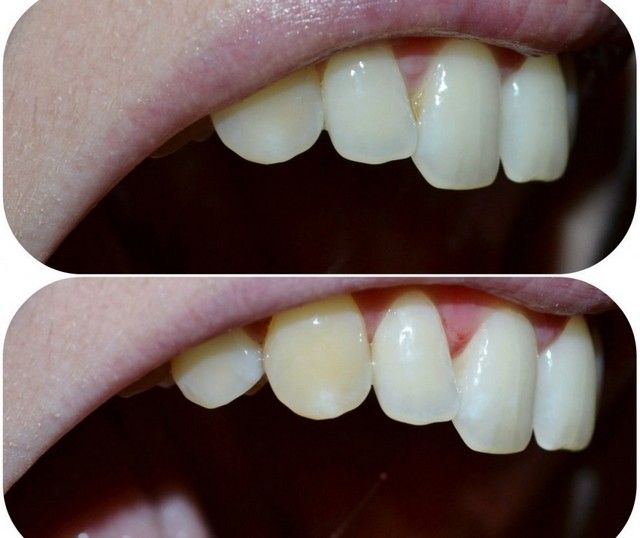
For those who care about the health of their teeth and do not strive to acquire an unnaturally white smile, it is enough to undergo professional teeth cleaning 2-3 times a year using the Air Flow device. This will preserve the natural color of the teeth and prevent many oral diseases.
The main cause of tooth decay during life and the appearance of pain, and in rare cases, premature tooth extraction, is poor oral hygiene. The formation of plaque on teeth due to gastritis, smoking, and improper brushing provokes a change in their shade and disruption of the enamel structure. As is known, the most effective treatment– disease prevention, in other words, this means professional teeth cleaning. Timely brushing of teeth makes it possible to prevent and avoid caries treatment.
Hygienic cleaning is carried out by a dentist using cleaning pastes or one of the new treatment methods. It is believed that hygienic cleaning of enamel is a kind of bleaching. But that's not true. Professional cleaning makes it possible to prevent caries and restore the natural color of teeth. Remember that it is with hygienic treatment that treatment of the oral cavity should begin, since the main condition for high-quality treatment (filling, prosthetics, surgical treatment, implantation, orthopedic treatment) is a healthy and thoroughly sanitized oral cavity.
In addition to dental plaque, there are also invisible deposits under the gums, and their existence can lead to periodontitis, loosening and loss of teeth. The presence of these diseases is determined by the doctor during examination.
Teeth whitening using the modern Air Flow method
There is currently a strong increase in patient interest in teeth whitening using the new Air Flow method, which improves health and appearance teeth.
Such methods of whitening tooth enamel are focused primarily on increasing the brightness of teeth without mechanically changing the structure of the tooth surface. The simplest method of whitening in this sense is professional hygiene, which can remove plaque and dental deposits, as well as ensure thorough cleaning of the spaces between the teeth.
Among the large number of different factors that influence the attractiveness and aesthetics of teeth, one of the most important is their color. The return of natural light color due to chemical or mechanical removal of pigmented surface plaque is commonly called bleaching. But it is worth noting that the use of the method of removing plaque using Air-flow water-air-powder technology in reality is not real whitening and serves only as an auxiliary procedure that returns the teeth to their real color. As a result of using professional hygiene Air-flow, the amount of reflected light increases, and this leads to the fact that teeth appear lighter, and no changes occur in the structure of natural enamel and dentin.
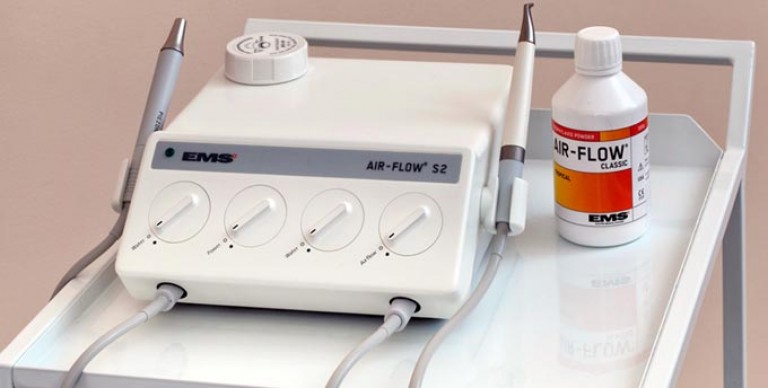
Air-Flow, or in other words professional removal of pigmentation and tartar, is recommended for those patients who have a large amount of pigmented plaque accumulated on their teeth. Also, do professional hygiene Doctors recommend the Air-Flow method to people with crowded teeth. A significant role in pigmentation is played by the abuse of coffee, tea, and especially red wine and smoking. Black spots on the enamel can be removed with an Air Flow device, or with a sandblasting device, which is configured to treat the tooth surface with a powerful stream of air with abrasive. The main components in this matter are: sodium carbonate - soda, which removes pigment. At the same time, no damage to the enamel occurs and the patient is left with a clean, beautiful smile.
- Removing plaque from tooth enamel and pigmentation.
- Prevention of periodontal disease.
- Preparing teeth before home and clinical whitening.
- Removing pigment after removing braces.
If teeth whitening using the Air Flow method is not enough, another whitening method is used. One such method is clinical professional teeth whitening using the Zoom system.
Remember that in modern dentistry, the Air Flow method of tooth enamel whitening acts as an excellent alternative to the outdated method of mechanical whitening. Both doctors and patients have already assessed the affordable cost of teeth whitening using this method. Reviews of whitening using the Air Flow method indicate that the procedure is as painless as possible; as for reviews of Air Flow teeth whitening from dentists, they are also positive.
Areas of use of Air Flow whitening technology
- In aesthetic dentistry;
- In the treatment of caries;
- The process of the procedure.
- In orthodontics.
Preparation
Patients do not require any special preparation before whitening with the Air Flow method. But, in any case, it is better to consult a dentist about possible complications.
The duration of this procedure is one hour. Air Flow whitening technology is suitable for whitening tooth enamel from coffee, cigarettes, tea and many other tooth surface pigments.
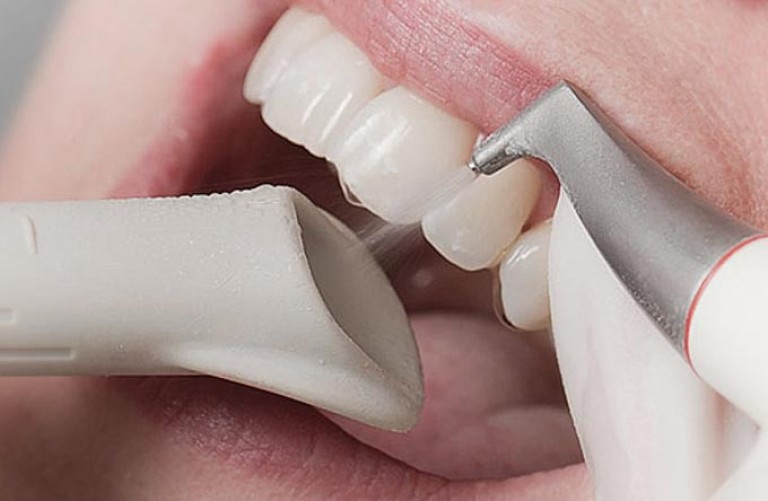
Whitening process using air flow technology
The technology for teeth whitening using air flow goes like this:
- The patient wears special safety glasses and a cap to prevent dust from getting into his hair or eyes;
- In order to protect the lips from drying out, the dentist applies Vaseline to them;
- The saliva ejector tube is placed in the mouth under the tongue;
- Next, they turn on a special apparatus that supplies a mixture of air, powder and water under pressure. The basis of this powder is sodium bicarbonate. The powder has a pleasant taste;
- The dentist brings the nozzle of the device close to the teeth, as a result of which plaque is removed from the surface of the tooth enamel and the tooth becomes naturally white. The enamel is not injured during the procedure.
- At the final stage of the procedure, a protective gel is applied, which increases the effect of this cleaning.
Rehabilitation period
Further, after teeth whitening using the Air Flow method, it is recommended to temporarily refrain from smoking, drinking coffee, tea and other products that lead to contamination of tooth enamel. Over time, the protective film destroyed during cleaning, the organic film that covered the teeth, is restored
Contraindications
Despite the fact that the procedure is safe, there are still certain contraindications. This procedure cannot be performed:
- Patients with bronchitis and chronic asthma;
- Patients with poor tolerance to citrus smell and taste;
- Not recommended for people who sit on salt-free diet, since the powder contains salt;
- Patients with periodontal disease.
After teeth whitening using the Air Flow method, complications usually do not arise.
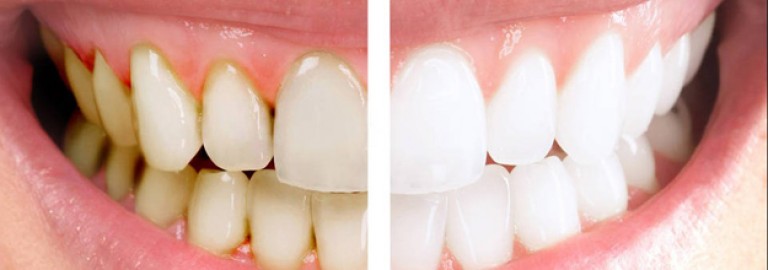
Cost and clinics
The procedure for whitening tooth enamel using this method can be done both in regular dental institutions and in private hospitals. It should be noted that compared to other methods of teeth whitening, Air Flow prices are relatively low. The cost of a standard procedure in an average Moscow clinic including a minimum package of services is around 2,500 rubles. In free clinics, this procedure is performed free of charge once a year (depending on your policy and the type of compulsory health insurance).
Cleaning process
The jet gently and carefully affects the surface of tooth enamel, practically without injuring it. What are the benefits of teeth whitening using the Air Flow method? This cleaning of tooth enamel makes the tooth surface more even and smooth, which means harmful microbes will not stick. Further, after cleaning, patients experience no unpleasant odor from the mouth and no bleeding. Whitening is performed at a professional level using advanced equipment and modern materials.
The powder hits the tooth surface under strong pressure and thus removes plaque. The dental assistant brings a special vacuum cleaner to the other side of the tooth being treated. Waste powder, water, and plaque particles are collected by this vacuum cleaner in the mouth without scattering throughout the office.
In a paid clinic, patients are usually offered professional comprehensive teeth cleaning using the Air Flow method:
- Removing plaque (including from food dyes and smoking).
- Washing of periodontal gum pockets.
- Effective removal of subgingival tartar.
- Polishing the surface of the teeth.
Air Flow Teeth Cleaning Powders come in a variety of delicious flavors.
Benefits of the Air Flow teeth brushing method
- Using the Airflow method, you can also lighten your teeth without damaging your enamel. Brushing your teeth will also provide an excellent polishing effect.
- Professional cleaning AirFlow is the least traumatic method of preventing oral cavity and periodontitis.
- Since the main cleaning material in the Air Flow method is simple soda, the cleaning procedure with this method will never provoke the development of an allergic reaction.
Although the procedure is safe for your health, you should consult your dentist before visiting a hygienist.
Professional cleaning must be done at least once a year, because under the influence of the environment, after a year the varnish will lose its quality, which will lead to the appearance of caries and plaque. To maintain results, we recommend using.
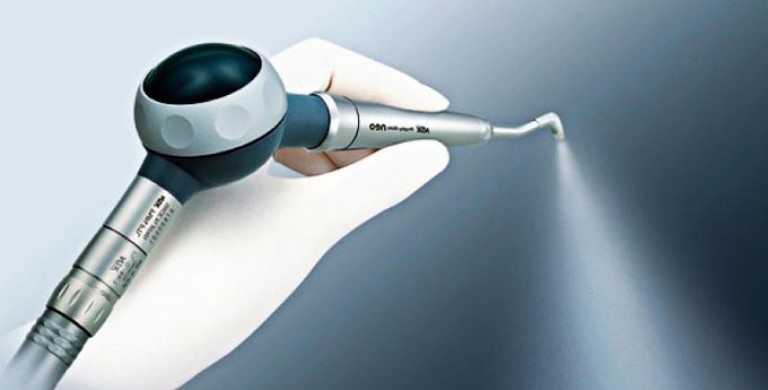
Prophy-Mate - device for Air Flow
Prophy-Mate guarantees unsurpassed cleaning and polishing results in the oral cavity. World experts “strongly recommend having Prophy-Mate equipment in every dental office,” say specialists in the production of dental medical equipment from NSK.
The visually attractive rounded shape is the result of NSK's in-depth research into ease of use and ease of operation. The grooves on the top of the handpiece provide a secure grip for the dentist's hand and simplified control of the handpiece. Convenient design and pleasant to the touch rounded shape, all this allows specialists to more accurately perform an important procedure related to Airflow oral hygiene - cleaning the dental surface from plaque.
Special dual nozzles direct air into the powder container, thus ensuring a stable flow of powder into the nozzle located in the container. Thanks to the power and continuity of the jet, an exceptional degree of polishing and cleaning is achieved.
The Prophy-Mate professional cleaning device has 2 joints on hinges, making it possible to rotate the head of the mechanism 360° for its mobility. The head rotates freely even at maximum air pressure, and the lightweight body reduces hand fatigue.
The front nozzle can be easily removed. This also further simplifies sterilization and oral hygiene.
Remember that good hygiene is the key to your natural beauty and health!
The cause of dental diseases is most often bacterial plaque, which accumulates on the surface of the teeth in the form of deposits. Most of them are located near the gum line and in the interdental spaces.
But, besides this, the entire surface of the tooth is covered with bacterial plaque, invisible to the eye. It penetrates the pores of the enamel and causes it to darken. To solve this problem, dentists proposed a method of cleaning and brightening teeth - Air flow.
What is it?
The Air flow method is a procedure for cosmetic cleaning of teeth by influencing them air-water flow with an admixture of fine particles.
Simultaneous spraying of three components allows you to efficiently remove dirt from the surface without damaging the enamel. Similar procedure gives the effect of slightly lightening teeth to their natural shade.
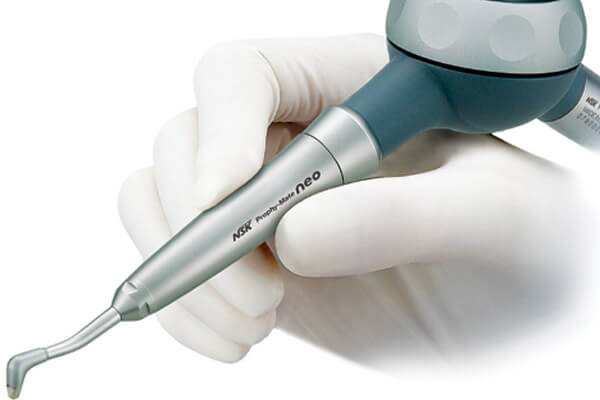
Purpose of the procedure
This procedure is primarily aimed at removing soft and dense plaque from the surface of the teeth where it is difficult to properly clean with a regular brush: the interdental space, extracted teeth, and the gum line.
The procedure is also aimed at solving the problem of darkening of the enamel, effectively removing pigment from its pores.
Advantages and Disadvantages
Compared to other methods, Air flow has clear advantages:
- gentle effect on enamel. Thanks to the combination of finely dispersed cleaning powder, water and air, there is no damage to the enamel;
- can even be used if available fillings, veneers and artificial crowns;
- along with cleansing it is provided full antibacterial treatment;
- is one of the most effective preventive measures from carious lesions and periodontal inflammation;
- together with the removal of deposits is carried out surface grinding enamel, which allows you to achieve a leveling effect;
- absolute painlessness procedures;
- no discomfort;
- is minimized soft tissue damage;
- The procedure lasts a short period of time - on average 30 minutes;
- the opportunity not only to clean your teeth, but also to multi-tone whitening to a natural shade;
- after cleaning, in rare cases, only minor increased sensitivity of enamel;
- suitable for braces, prostheses and implants;
- no allergies.
In addition to its advantages, this technique also has some shortcomings:
- hard dental plaque are difficult to influence by Air flow. Most often, this requires additional use of other methods;
- It is possible to whiten teeth only a few shades, but no whiter than their natural shade;
- using this device It will not be possible to remove deposits from under the gums;
- in the absence of proper dentist experience Possible gum damage.
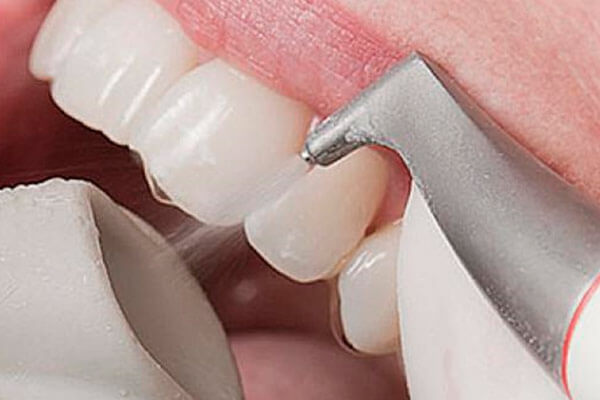
Indications
The use of this method is indicated in the following cases:
- darkening of the enamel;
- presence on the surface of teeth individual pigmented spots;
- education plaque in the interdental space;
- availability orthodontic diseases. The technique is used as a means to reduce the number of bacteria;
- chronic inflammation of periodontal tissue: periodontitis, periodontal disease, gingivitis;
- before the main one professional whitening procedure;
- availability of implants, dentures, braces;
- prosthetics.
Contraindications
The Air flow method cannot be used if the patient has one of the following contraindications:
- salt-free diet which the patient adheres to;
- period breastfeeding or pregnancy;
- pathologies of the bronchi and lungs in chronic form;
- kidney diseases in the acute period;
- high enamel sensitivity or its rapid abrasion;
- allergy to flavoring additives included in the cleaning product;
- periodontal pathology in acute form;
- children's age up to 15 years.
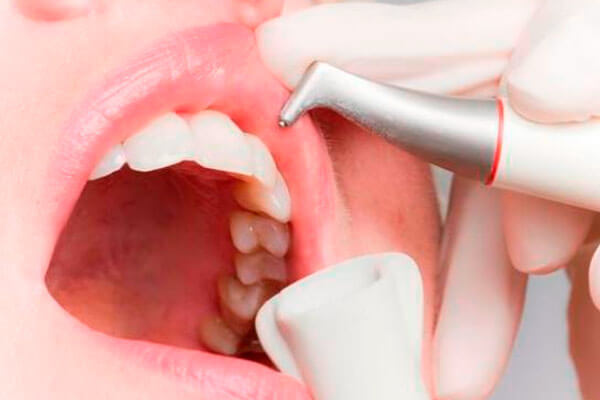
Operating principle
The principle of operation of the device is to influence the enamel with a special mixture consisting of air, water and cleaning powder, which is supplied under pressure.
Used as a cleanser sodium bicarbonate - soda.
The substance is used only in the form fine powder, which is poured into a spherical container located on the handle of the device. On the device itself there are two containers, each of which is equipped with a pump.
One container is designed to supply water, and the other - air. Both components enter a tube leading to a spherical cavity, and there mixed with soda and compressed air fed through a rotating tip handles onto the enamel surface.
The tip is equipped with an internal mini-turbine, due to which it is formed pulse spray flow. The flow rate can be reduced or increased by a special regulator located on the main body of the device.
The handle has an ergonomic design and is equipped with special grooves that make it easier to grip and apply precise pressure to the teeth. All structural elements are made of lightweight materials, which eliminates hand fatigue. In addition, the work is facilitated by the high mobility of the tip with a rotation angle of up to 360°.
The tip and delivery nozzle can be detached if necessary. This makes it possible to carry out complete sterilization these elements.
How is the procedure performed?
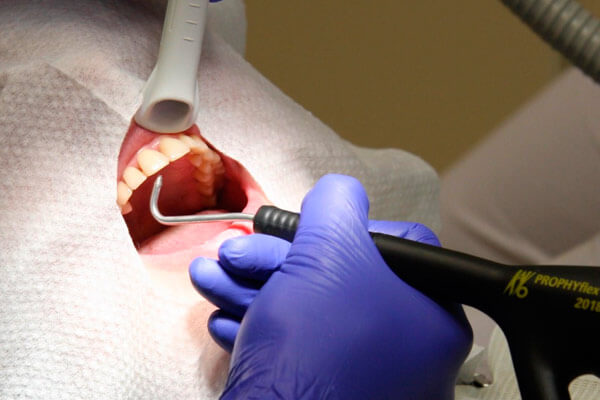
The purification process using Air flow technology takes place in 30 minutes. The whole procedure consists of several steps:
- In order to ensure that during manipulations the mucous membranes of the lips did not dry out, the dentist treats it with Vaseline or a product based on it.
- Despite the fact that the effect of the cleaning stream is carried out only in the oral cavity, additionally protect your eyes too, putting on special glasses. In some clinics, they even cover their heads with a disposable cap.
- Dental assistant places a disposable nozzle in the patient's mouth saliva ejector or vacuum cleaner. The saliva ejector attachment is placed in the lower part of the mouth and is designed to remove fluid that accumulates on the mucous membranes under the tongue during cleaning.
The vacuum cleaner nozzle is made in the form of a rectangular tube, which has an elongated lower edge and a shortened upper edge.
Unlike a standard saliva ejector, the vacuum cleaner tube is placed directly in the area of the tooth being treated. During cleansing, the supplied stream, along with deposits, enters the nozzle, practically not reaching the mucous membrane.
- Dentist begins to cleanse from the lingual side of the teeth to upper jaw, while holding the tip at an angle of 30 – 60° relative to the enamel. The angle is selected depending on the position of the teeth and the impact surface.
- At first spray the interdental spaces up and down movement. Then, using a circular motion, the lingual surface and cutting part are cleaned.
- Exactly the same cleanse vestibular side of the teeth of the lower jaw.
- After detailed treatment of all teeth, the dentist performs them grinding using a special leveling paste for this. Then the doctor washes it off with water and dries the enamel surface.
- Finally, on the dried surface of the teeth apply gel based on fluoride, which is aimed at restoring and strengthening enamel. It will help minimize the occurrence of high enamel sensitivity.
During cleansing, the dentist must avoid exposure of the gum tissue to the jet.
Care
Enamel after exposure to Air flow loses its protective film, which begins to recover only after a couple of hours, and is fully formed in about a day. In order not to reduce the cleaning results to the initial level, it is necessary to comply with a number of certain rules:
- cannot be consumed coloring and solid products;
- should eliminate the impact on teeth nicotine or alcohol;
- should not be used decorative cosmetics for lips;
- It is recommended to use a paste for cleansing, reducing sensitivity enamel and brush only with very soft bristles;
- It is also recommended to include in care rinses with remineralizing complex.
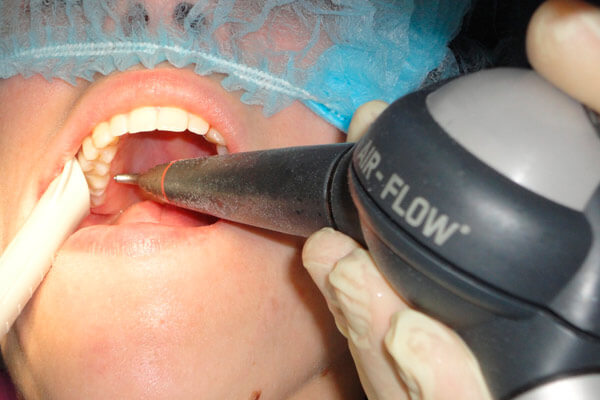
In the future, in order for the whiteness effect to remain as long as possible, it is also recommended to follow some rules:
- To clean, you need to use not only a classic brush, but also additional devices: irrigator, floss, brushes, rinses;
- Visit your dentist regularly for professional cleaning;
- timely eliminate dental pathologies;
- carry out additional whitening activities available for use at home: gels, toothpastes, strips.
Price
Having appeared not so long ago, the Air flow method immediately became in demand. This is explained not only by the high efficiency of the procedure, but also by its reasonable cost.
On average, using Air flow will cost 1.5 thousand rubles.
The real cost of the service in clinics is much higher, since in addition to this procedure, it almost always includes a whole range of additional activities: ultrasonic removal of old hard deposits, remineralization.
As a result average price for this service is about 5 thousand rubles. Depending on the status of the clinic, it may increase or decrease slightly.
Opinions
Basically, those who experienced this technique were satisfied with the results obtained and expressed their readiness to continue to regularly carry out this procedure.
And in this video, a specialist expresses his opinion about the technique:
If you find an error, please highlight a piece of text and click Ctrl+Enter.
Modern dentistry can quickly and effectively clean teeth of plaque and stones using conventional methods, but air flow teeth whitening can best help with stains that appear on the enamel.
Basically, enamel loses its color as a result of the appearance of a thick layer of plaque or tartar on it. These components are formed from microbes and food debris that has not been cleaned and, in addition to the fact that such deposits do not look aesthetically pleasing, they are also the cause of many pathologies in the oral cavity.
Stains on the enamel can appear as a consequence of smoking or excessive consumption of coloring products (coffee, wine). In addition, some types of medications can have a detrimental effect on it, but still the main reason is always poor oral hygiene, and to correct the situation you will need to use the air flow method of professional teeth cleaning.
Process Features
You can brush your teeth using air flow technology no more than 2 times a year and only if there are no contraindications. As for children, it is suitable for children over 8-10 years old, because, in fact, it is just a jet of liquid, which does not contain harmful chemical elements that can destroy enamel, in addition, the device has a convenient power adjustment, which allows need to reduce blood pressure.
In addition to its main function, this technique can be used for other pathologies of the oral cavity, as well as for prosthetics and other types of dental interventions.
Before starting the procedure, the doctor will tell you in detail what air flow is in modern dentistry.
Teeth cleaning procedure
Air flow teeth cleaning was opened to the whole world by the Swiss company EMS and despite such a simple mechanism of action, the procedure is one of the most popular today. The principle of its operation is to soften plaque (stones) and then remove it.
During the procedure, the patient is seated in a chair and the doctor directs a stream of a special solution into the oral cavity, which consists of powder, air, glycine (calcium) and water. Next, the dentist begins to move the device with gentle circular movements, gradually removing all food debris and plaque from the interdental spaces. At the same time, completely cleaning the cavity from microbes and polishing the enamel surface.
The duration of teeth cleaning with sandblasting depends on the severity of the case, but generally no more than an hour, and if the oral cavity is in good condition, then no more than 15-20 minutes. Unlike ultrasonic whitening, this process is gentler and less likely to damage the enamel.
Composition of cleaning powder
The powder included in the sandblasting jet is created from various components and can be given a certain taste or aroma.
 Today, the manufacturing company produces powders of 3 brands: classic, soft, perio, and they all have the following features:
Today, the manufacturing company produces powders of 3 brands: classic, soft, perio, and they all have the following features:
- The main component of the powder used in hospitals is soda;
- If there are no contraindications, then you can use an aerosol that contains calcium. It penetrates and cleanses the enamel better and allergic reactions are less likely to occur;
- When using glycine powder, which has a less irritating effect and is more gentle during the polishing process.
The gentle handling of the low-strength powder and the special head of the device through which the jet comes out guarantee that after brushing your teeth with Aeroflow, the enamel will not be damaged.
Step-by-step analysis of cleaning
The entire air flow teeth cleaning process is divided into the following stages:
- Initially, the doctor, in order to avoid drying out the patient’s lips, applies a layer of Vaseline ointment to them;
- After this, in order to protect the eyes from the jet, special glasses are put on the patient;
- Next, a saliva suction is installed;
- After which the procedure itself is carried out and this requires mainly 2 people, so that one of the doctors directs the jet of the device in turn to each tooth, and his partner removes the used water and softened plaque residues;
- When the cleaning is completed, the enamel is strengthened with a special composition containing fluoride or gel, but if this procedure was only part of the process, then this is not done until the main part of the treatment is completed;
- Do not eat or drink after brushing your teeth with airflow. coloring products about 3 o'clock. This time should be enough for the pellicle layer to return, which is the natural protective layer of enamel. At the same time, it is better to sit on liquid food for another 2-3 days to avoid damage to the gums.
Thus, the procedure is quite simple and quickly performed, but it has its advantages and disadvantages, as well as contraindications.
Pros of the procedure
Air flow teeth cleaning has the following distinct advantages:
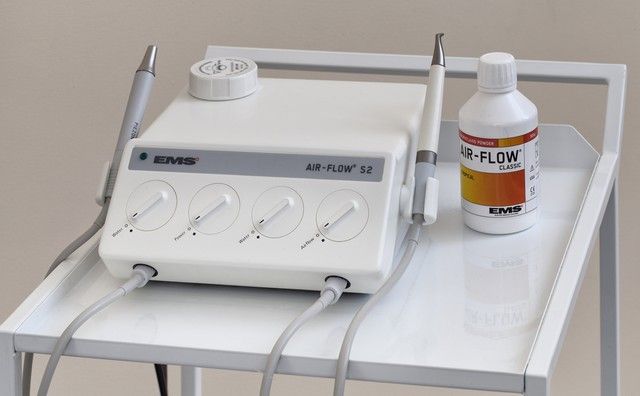
This product copes well with stains on enamel that were acquired with age and the temperature of the directed jet is quite comfortable and pleasant.
Contraindications and disadvantages of the procedure
Air flow teeth whitening, in addition to its advantages, also has certain disadvantages:
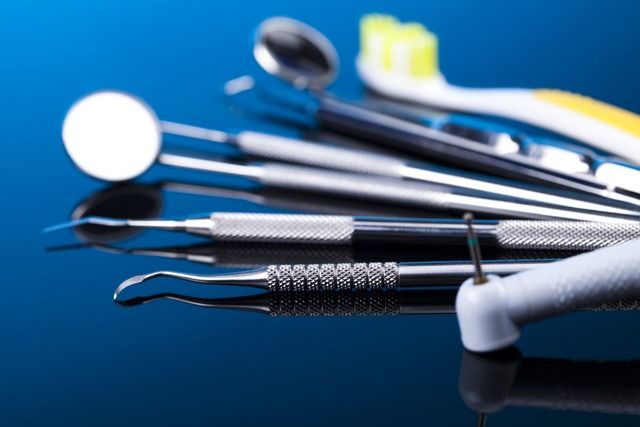
In addition, you need to take into account that you cannot use air flow teeth brushing in the following cases:
- For diseases of the bronchus;
- During pregnancy;
- For chronic pathologies that have started to worsen;
- For diseases that were caused by infections;
- With multiple carious formations in deep stages;
- At inflammatory process in the oral cavity;
- If stomatitis caused by herpes is present;
- For tuberculosis, HIV or hepatitis.
Thus, air flow is a professional method of cleaning and whitening teeth to their natural shade, but you should be examined before the procedure to avoid complications.
Air Flow teeth brushing is a popular hygiene procedure. It allows you to make the enamel whiter and serves as the prevention of caries.
Brushing your teeth using the Air Flow method is safe and painless. After it, a feeling of freshness remains in your mouth for a long time, and your smile becomes snow-white and attractive.
Maybe it’s time for you to do a flow cleanse too, but you just don’t know about it yet? From the article you will learn everything about this procedure and can decide whether it will benefit you.
Air Flow is a technology for abrasive professional cleaning of tooth enamel. The Air Flow technique allows you to remove plaque from those places where the brush does not penetrate: in the interdental crevices and recesses of the enamel layer.
The name of the technology translates as “air jet”. Despite the name, cleaning is not done with air, but with calcium bicarbonate or, more simply, baking soda.
Soda is supplied from the tip of a special apparatus under high pressure. It is first mixed with water and air, resulting in a kind of soda aerosol.
Hitting the enamel, the smallest particles of soda knock down mineralized deposits, and the water-air mixture washes them and the soda itself off the surface of the tooth.
Often aromatic substances are added to the mixture, giving it a pleasant smell and taste and freshening the breath.
All reviews indicate that, despite the continuous supply of water to oral cavity, cleaning Air Flow does not cause any discomfort.
A nozzle is inserted into the mouth to suction the water so that the patient does not have to choke or swallow the soda mixture.
Moreover, there are frankly enthusiastic reviews regarding this procedure. All patients note the high effectiveness of the method. The water-air-abrasive mixture goes around each tooth, cleaning out deposits everywhere.
The results of cleaning last a long time; there are reviews that even after a year, the teeth remain as bright, clean and healthy as immediately after brushing.
If you have darkening of the enamel in the form of tartar, then Air Flow will help restore your teeth to their original appearance.
How does Air Flow professional cleaning work? The patient enters the office wearing shoe covers and sits in a regular dental chair.
They put a waterproof bib on it and start cleaning. The cleaning itself takes about 30 minutes.
The dentist directs the jet not at the gum, but away from it, holding the nozzle at an angle of 30 - 60 degrees. Finally, the patient is asked to rinse his mouth and brush his teeth. professional paste using an electric toothbrush with a rubber tip instead of a regular toothbrush.
The size of soda particles is so small that it allows them to penetrate into the interdental spaces, but at the same time they do not injure the gums.
But if the gums are “weak”, then they may experience slight bleeding. At hypersensitivity gums, the doctor may suggest local anesthesia, which consists of treating the soft tissues with a cotton swab soaked in lidocaine.
The sensations from the procedure are pleasant, similar to those experienced when massaging the gums. The impact of soda particles on the mucous membrane is not felt at all, but the bubbles of foam are very pleasantly felt.
After the cleaning is complete, your dentist may suggest a fluoride varnish. This drug protects against painful sensations, which may occur in the first days after cleansing.
Fluoride varnish envelops the teeth like a film and comes off on its own after a few days. It should be taken into account that until the fluoride varnish comes off from the teeth, it will give the enamel a yellowish tint.
Who needs teeth cleaning?
Why do you need professional Air Flow cleaning: just for beauty or for protection against caries? Or so that dentures and fillings last longer?
The correct answer is that the entire body needs Air Flow cleaning. Teeth are not only a “calling card” and organs for grinding food.
The dental system is connected to all digestive organs and affects their functioning. Healthy teeth without tartar and other foci of infection - this is the key to not only a beautiful smile, but also general health.
Everyone without exception needs the Air Flow device. Everyone has deposits on their teeth.
For some they are a soft plaque, while for others they have already become mineralized and turned into tartar.
Any deposit on the teeth is a place where microbes accumulate and a potential source of infection. If you do not clear the enamel of stones in time, then over time gum inflammation will begin, and then periodontitis.
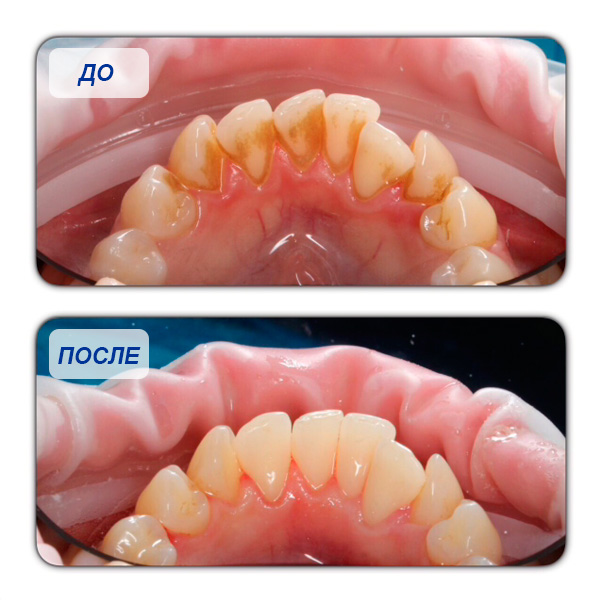
Surprisingly, many people do not even suspect that without professional cleaning their teeth are in serious danger. Periodontitis does not manifest itself in any way at first.
Its first noticeable symptoms are bad breath and slight bleeding of the gums.
To solve the problem, simply remove all deposits regularly - this guarantees the absence of periodontal disease.
Direct indications for Air Flow cleaning:
- dental deposits on enamel;
- darkening of teeth;
- cleaning braces or implants;
- cleaning ceramic bridges;
- enamel lightening;
- cleaning the tooth before microdiagnostics or mineralization.
Air Flow cleaning is a harmless procedure, but it also has a few contraindications:
- diseases of the lungs and bronchi, including asthma;
- allergy to soda or aluminum (sometimes an aluminum compound is used instead of soda in devices);
- weak, thinned enamel;
- numerous unfilled carious cavities;
- acute periodontal disease.
Contraindications for cleaning Air Flow are pregnancy and lactation.
After cleaning Air Flow, you must refrain from smoking and consuming products containing natural or chemical dyes for at least a day.
These contraindications must be observed, otherwise the enamel will quickly lose its newly acquired whiteness.
The fact is that approximately 24 hours after brushing, it easily and quickly absorbs everything that gets on the surface of the teeth.
Which cleaning is better - ultrasonic or jet?
Modern dentistry offers a choice of several methods of professional teeth cleaning. Ultrasonic cleaning is no less popular than Air Flow.
Therefore, a legitimate question may arise - which method is better? If we rely on the reviews of doctors, we can conclude that Air Flow cleaning is useful for those whose teeth have turned yellow from smoking, and ultrasonic cleaning is better at preventing caries.
During ultrasound, they are crushed and washed off with water. Ultrasound not only cleanses the enamel of contaminants visible to the naked eye, but also kills germs and bacteria living under the gums and in the spaces between teeth.
Ultrasonic cleaning does not have a mechanical or chemical effect on the tooth surface. This method is considered completely safe for enamel, since the scanner does not come into contact with it.
However, ultrasonic cleaning is not for everyone. The method is contraindicated in patients with pacemakers and heart disease. Ultrasound waves can damage dental implants and bridges.
The Air Flow procedure will not help get rid of large tartar, it only removes soft plaque. Ultrasonic cleaning removes even the hardest deposits.
The optimal cleaning method would be a combination of these methods, when large mineralized deposits are removed point by point with an ultrasonic scanner, and then finishing is carried out with an abrasive jet.
The table provides a comparative description of the two methods.
| Ultrasound | Air Flow | |
| Effect | Removal of tartar, including from under the gums, prevention of caries | Removing pigmentation, cleaning enamel before whitening or installing braces |
| Who is it shown to? | Everyone | For everyone, especially smokers, coffee and strong tea lovers |
| For whom it is contraindicated | People with implants, artificial crowns and bridges | People with deep caries chronic diseases respiratory system, weak enamel |
| Frequency | Once every six months | Once every six months |
| Duration | 40 minutes | 30 minutes |
| Result | Whitening enamel, sterilizing tooth surfaces, relieving inflammation | Enamel lightening, plaque removal, tartar prevention |
Dentistry today offers a third method of cleaning enamel - with a laser. Laser cleaning allows you to very carefully clean your teeth from soft and mineralized plaque and, in addition, whiten them.
The disadvantage of the procedure is that it cannot be called cheap and accessible. Not every clinic has equipment for laser cleaning.
Doctors say that professional Air Flow cleaning is a mandatory procedure that must be carried out every 6 to 12 months.
If you have long forgotten natural color your teeth, then be sure to go to Air Flow. Indeed, in this case, for a reasonable and very affordable amount, you get the maximum benefit - all the reviews say so.
